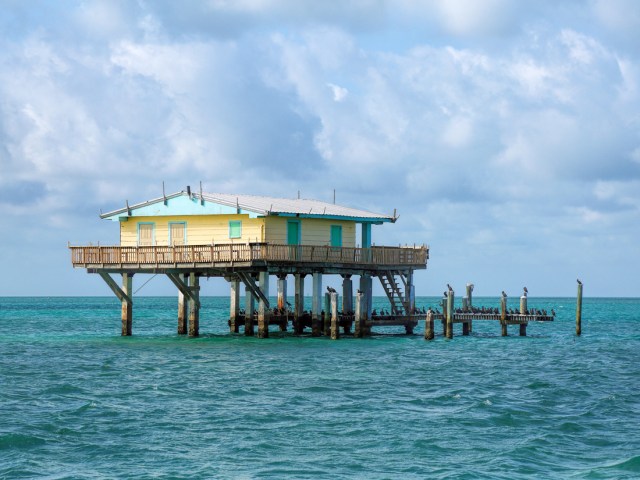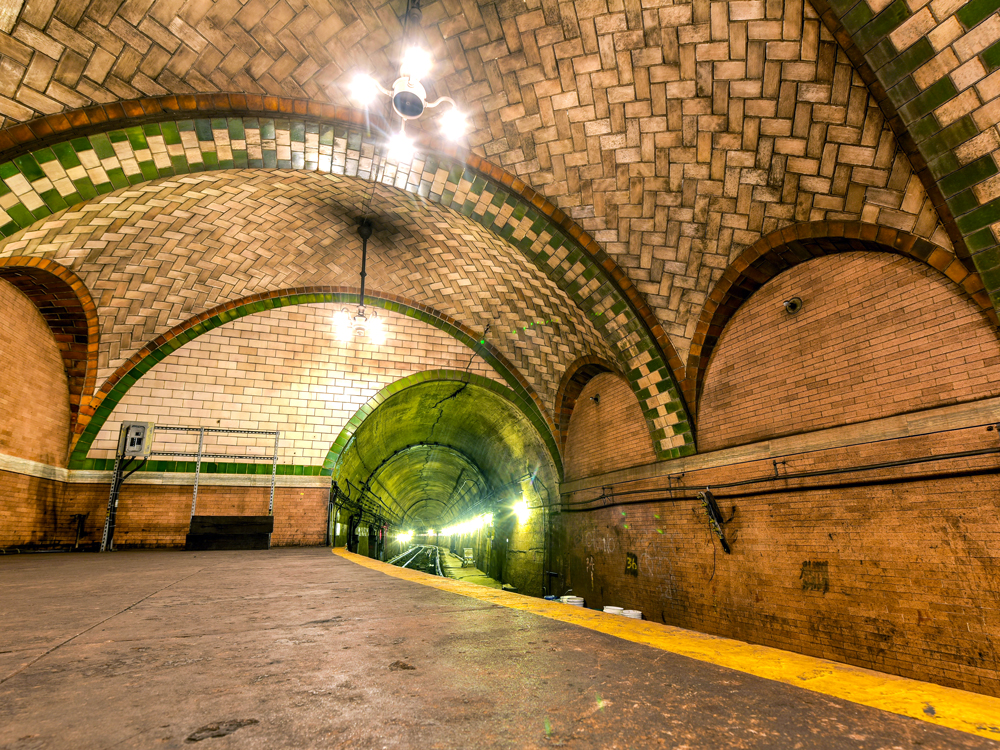From the Pacific Northwest to the Southwest, Midwest, South, and New England, America is filled with breathtaking historic landmarks. You’ve probably crossed quite a few of the most famous ones off your list already, but we bet these eight attractions haven’t made it on your radar yet. From an abandoned community of homes on stilts to a hidden subway station in the Big Apple, check out eight of America’s most fascinating and underrated historic attractions.
Loveland Castle – Loveland, Ohio

If you ignore the cars in the parking lot, you might think you’ve landed in medieval Europe as you gaze up at Loveland Castle. Situated on the banks of the Little Miami River about 25 miles northeast of Cincinnati, Loveland Castle (also known as Château Laroche, meaning “Rock Castle”) is the work of one man. The castle’s founder, Sir Harry Andrews, spent more than 50 years building the fortress himself using handmade bricks. Andrews served as a medic in World War I and was also a professor, Sunday school teacher, author, notary public, and Boy Scouts leader.
In the early 1920s, Andrews met regularly with a group of Boy Scouts who called themselves the Knights of the Golden Trail and engaged in a variety of outdoor adventures such as camping. Andrews built a couple of stone structures to make camping easier for the KOGT. He later decided his knights needed a real castle, so he spent the next 50 years building an authentic fortress — complete with a bell tower, moat, dungeon, garden, trick stairs, and a battle deck. Today, members of the KOGT maintain the castle, stand guard, and offer tours.
Stiltsville – Miami, Florida

Just a few miles offshore of glitzy Miami Beach, in Biscayne Bay’s shallow waters, sits an abandoned community of homes built on stilts. Local fishermen built the first structures here in the 1920s, and at one point, 27 structures were perched above the water. Far enough offshore to be somewhat immune to gambling and alcohol regulations, Stiltsville had a reputation for partying and housing a strip club on a permanently anchored barge. Multiple hurricanes have since destroyed many structures, but a few still exist.
Today, you can visit by boat and by permit only. However, many unofficial boat tours pass by the remaining structures. Stiltsville sits just south of Key Biscayne, which is accessible via the Rickenbacker Causeway from Miami. This quiet, five-mile long barrier island is worth a visit on its own, since it’s home to spectacular beaches and two large parks: Crandon Park and Bill Baggs Cape Florida State Park. You can also climb the nearly 200-year-old Cape Florida Lighthouse and check out the panoramic views of Stiltsville, Biscayne Bay, and the Miami skyline.
Harmony, Minnesota

Nicknamed the “Biggest Little Town in Southeast Minnesota,” Harmony is part of what’s known locally as Bluff Country. Visitors can drive along nearby Historic Bluff Country Scenic Byway and hike along fabulous trails overlooking the Mississippi River from vantage points between high wooded bluffs. Birders can also enjoy spotting bald eagles, hawks, and migratory birds. Harmony lies at the southern end of the Harmony-Preston Valley Trail System, an 18-mile, picturesque trail that connects with the Root River State Trail.
Once you’re done exploring the trails, check out Niagara Cave, a 200-foot-deep limestone cave with underground waterfalls, fossils, streams, stalagmites, and stalactites. Minnesota’s largest Old Order Amish community also lives in Harmony’s countryside, and Amish buggies are familiar sights along area roads. Learn about Amish history and culture on a tour and shop for homemade baked goods, furniture, baskets, quilts, and more.
Deadwood, South Dakota

Western legends such as Wild Bill Hickok, Sheriff Seth Bullock, and Calamity Jane once called this historic Gold Rush town home. After a miner struck gold in the Northern Black Hills in 1875, thousands of prospectors swarmed the area, which was named for the many dead trees that lined the canyon. The U.S. military under General George A. Custer (unsuccessfully) tried to prevent the miners from swarming the Black Hills region because the Lakota-Sioux owned it as part of a treaty.
Learn about the area’s colorful history and its infamous inhabitants on one of many tours, try your hand at gold panning, and take in the scenery on a vintage steam train ride. In summer, Wild West reenactors roam the streets and perform. Given Deadwood’s long history of saloons, it’s no surprise that you’ll find quite a variety of wineries, wine bars, breweries, and pubs.
Old City Hall Subway Station – New York, New York

If you’ve even taken the subway in New York City to get to your destination, you’re probably aware that gracefully vaulted tile ceilings, elegant chandeliers, and intricately leaded skylights are not part of the experience. Architects Heins and LaFarge designed City Hall Station in 1900 as part of the City Beautiful movement. As the subway’s first station, it opened in 1904 with much fanfare. Sadly, it was later shut down in 1945 after nearby stations became more popular. But today, No. 6 trains still use the track as a turnaround. If you want to see it in its full grandeur, it’s best to book a tour with the New York Transit Museum. Museum members receive priority for the 90-minute tours, which begin above ground with a historical walk.
Nevada City, California

This California Gold Rush town, located about 60 miles northeast of Sacramento, once boasted a population of 10,000 during its heyday in the mid-1800s. Few people call Nevada City home today, but if you visit, you might think you’ve stepped back in time. The town’s well-preserved historic district and its 93 buildings are listed on the National Register of Historic Places. You’ll find attractive Victorian-era homes, peaceful tree-lined streets, and California’s oldest, still operating performing arts structure, the Nevada Theater. If you enjoy the outdoors, you’ll find plenty to do nearby, including hiking, kayaking, road and mountain biking, fishing, and off-roading.
Boldt Castle – Alexandria Bay, New York

In 1900, hotel magnate George C. Boldt envisioned constructing a European castle-style summer mansion for his beloved wife, Louise. However, when Louise died suddenly in 1904, broken-hearted Boldt halted work and left the structure unfinished. The castle, which sits on lovely Heart Island in the St. Lawrence River, sat vacant for 73 years. In 1977, the Thousand Islands Bridge Authority acquired the property and invested several million dollars into restoring and finishing it.
Beautiful gardens surround the castle structures, which include a gazebo, two towers, and a picturesque, medieval power house and clock tower. The castle’s dramatic beauty and historical love story have made it a popular wedding venue and tourist attraction. You can’t stay overnight, but you can tour the castle, gardens, and the yacht house. Tour boats provide passenger service from Alexandria Bay, New York, and from Ontario, Canada.
Tarpon Springs Sponge Docks – Tarpon Springs, Florida

Before you could purchase synthetic kitchen sponges at your supermarket, the only sponges available came from the sea. Greeks have been harvesting the skeletal remains of these aquatic animals from the warm Mediterranean seabed for centuries. They even used weighted dive suits to make it easier to stay underwater and rake the sponges free. In the early 1900s, a Greek man named John Corcoris recognized that the Gulf of Mexico’s warm waters were home to similar aquatic sponges. In 1905, he recruited 500 Greek divers to come to Tarpon Springs, a town about 30 miles north of Tampa.
Soon, a bustling community was established around the docks where the sponge divers unloaded their harvests, and Tarpon Springs became known as the “Sponge Capital of the World.” More than 100 restaurants and shops line the Tarpon Springs sponge docks, and a thriving Greek community still exists today. In addition to filling up on authentic Greek cuisine, you can visit Spongeorama, an eclectic museum that tells the history of Tarpon Springs’ sponge diving industry.
More from our network
Daily Passport is part of Inbox Studio, which publishes content that uplifts, informs, and inspires.
















